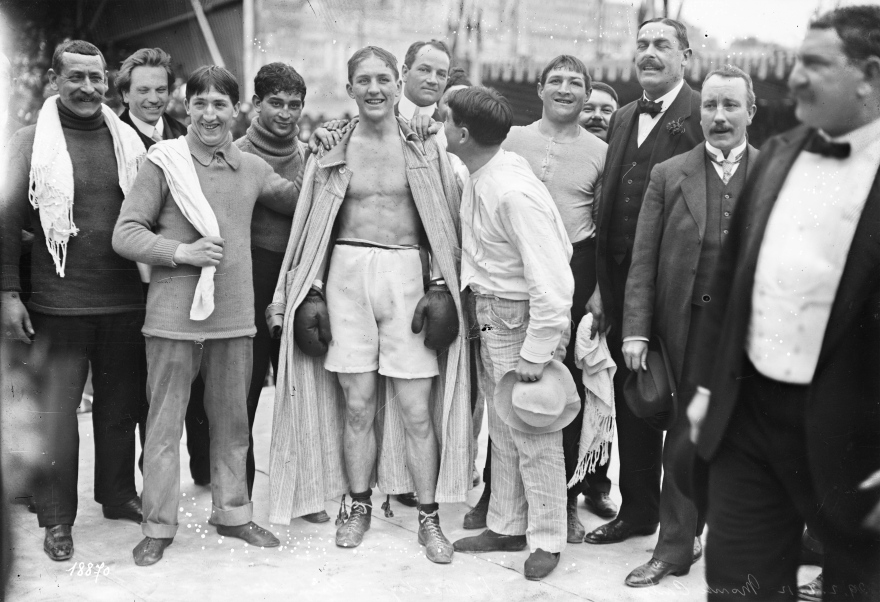
Georges Carpentier was a French boxer, actor and World War I pilot. He fought mainly as a light heavyweight and heavyweight in a career lasting from 1908 to 1926. Nicknamed the “Orchid Man“, he stood 182 cm and his fighting weight ranged from 126 to 175 pounds (57 to 79 kg). Carpentier was known for his speed, his excellent boxing skills and his extremely hard punch. The Parisian Sports Arena Halle Georges Carpentier is named after him.
Born in Liévin in Pas-de-Calais, Carpentier began his career by progressing up through the weight divisions, fighting in every division from welterweight upwards. After making his first professional bout at age 14, he was welterweight champion of France and of Europe in 1911, middleweight champion of Europe in 1912, and light heavyweight champion of Europe in 1913. On June 1, 1913, he beat “Bombardier” Billy Wells in Ghent, Belgium to become heavyweight champion of Europe. He defended his title in December against Wells, in January 1914 against Pat O’Keeffe and in London on July 16 he beat Ed “Gunboat” Smith to add the “White Heavyweight Champion of the World” to his European title. The white heavyweight title bout sported a purse worth 9,000 pounds sterling.
Carpentier was also a referee during the early stages of his career, supervising a number of fights including the world title bout between Jack Johnson and Frank Moran in June 1914. Carpentier was a French Air Force aviator during World War I and was awarded two of the highest French military honors, the Croix de Guerre and the Médaille Militaire. This served to heighten his already exceptional popularity, not only in France but in the United States and England as well.
Carpentier defended his title twice again in 1919 before dropping down a weight class to challenge Battling Levinsky for the light heavyweight championship of the world. The fight took place on October 12, 1920, in Jersey City and Levinsky was knocked out in the fourth. Carpentier’s attempt at the heavyweight Championship of the world came on July 2, 1921, again in Jersey City, when he faced Jack Dempsey in front of boxing’s first million dollar gate.
Carpentier was badly beaten around before suffering a knockout in the second minute of the fourth round. Carpentier never fought again for that title. He lost his world light heavyweight title and his European heavyweight and light heavyweight titles the following year, on September 24, 1922, in a controversial bout with Senegalese fighter Battling Siki. His last truly noteworthy fight was on July 24, 1924, with Gene Tunney at the Polo Grounds in Manhattan, New York City. Carpentier lost the bout by TKO after fifteen rounds. He retired from the ring after a final exhibition bout in 1927.
Following his retirement from boxing, Carpentier spent a number of years as a vaudeville song-and-dance man, mostly in England and the US. He is the author of a boxing novel, Brothers of the Brown Owl: A Story of the Boxing Ring published c. 1920 by Cassell and Company (being a volume in the uniform Cassell’s Empire Library). He also appeared in half a dozen motion pictures, starring in both silent films and talkies.
He made three films in Hollywood, one for director J. Stuart Blackton in England and two in his native France. His last screen appearance was in 1934. Soon after, he became proprietor of an upmarket bar, Chez Georges Carpentier, in a chic Paris neighborhood. In several different locations, this is the profession he would exercise until shortly before his death.
From the time they boxed together in 1921, Carpentier remained close friends with Jack Dempsey. They visited each other in New York and Paris, got together to commemorate the anniversary of their famous bout and exchanged birthday greetings.
He was elected to the International Boxing Hall of Fame in 1991.
Georges Carpentier est le premier boxeur professionnel français à devenir champion du monde de boxe anglaise.
Pugiliste précoce, Carpentier combat dans de nombreuses catégories. Champion de France professionnel à de multiples reprises, il s’impose avant la Première Guerre mondiale comme le champion d’Europe des poids lourds. Sergent aviateur pendant la Grande Guerre, il est blessé avant de réintégrer la vie civile. Il découvre alors le rugby à XV où il évolue au poste d’ailier.
À son retour sur les rings en 1919, « le grand Georges » marque l’histoire du sport français en rayonnant hors des frontières. Éblouissant de son art en Grande-Bretagne et aux États-Unis, il est célébré comme le symbole d’une France sportivement puissante. Sa victoire par KO contre Battling Levinsky le 12 octobre 1920 à Jersey City aux États-Unis lui permet de conquérir le titre de champion du monde. Son combat perdu au courage contre Jack Dempsey l’année suivante renforce sa légende et lui offre une notoriété mondiale. Cette défaite marque le déclin de son exceptionnelle carrière, ponctuée par la perte de ses titres au profit de Battling Siki sur un controversé bien qu’incontestable revers face au Sénégalais.
S’il prouve sur la fin de sa carrière qu’il reste un champion hors du commun, notamment lors de sa défaite pleine de panache face à Gene Tunney, Carpentier doit mettre un terme à sa carrière en 1926. Devenu une ancienne gloire, sa notoriété en fait toujours une figure de la boxe en France. Nommé ambassadeur du sport français à l’étranger après la Seconde Guerre mondiale à laquelle il participe dans l’armée de l’air, le Liévinois meurt d’une crise cardiaque en 1975. Une décennie après sa mort, la grande salle de basket-ball du 13e arrondissement de Paris est renommée en son nom Halle Georges-Carpentier. Il demeure un des meilleurs boxeurs français avec Marcel Cerdan.
Outre son talent pugilistique hors norme, la carrière de Georges Carpentier se distingue également par le statut de célébrité, voire de « star », qu’il a acquis au fil des ans.